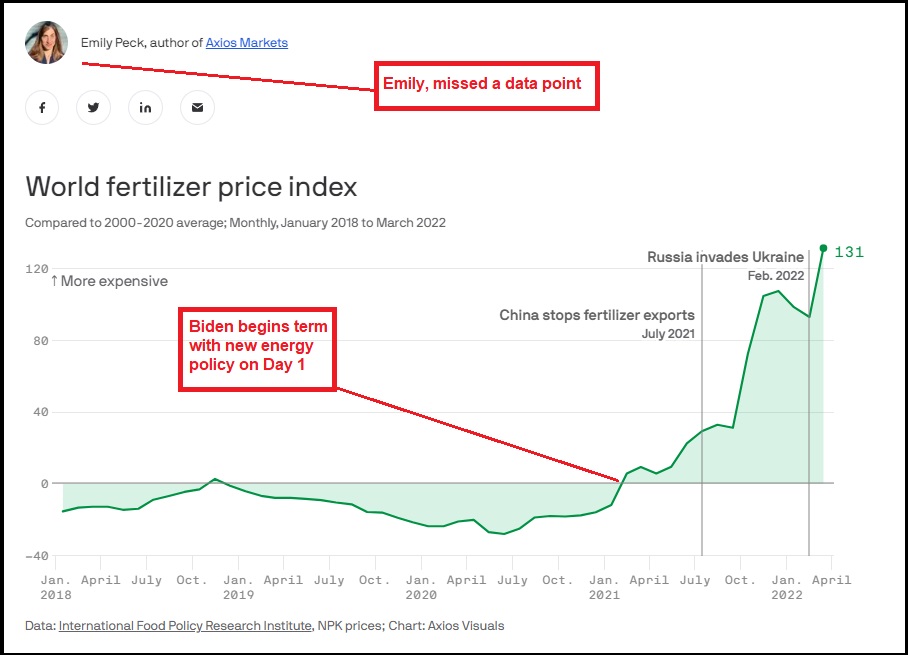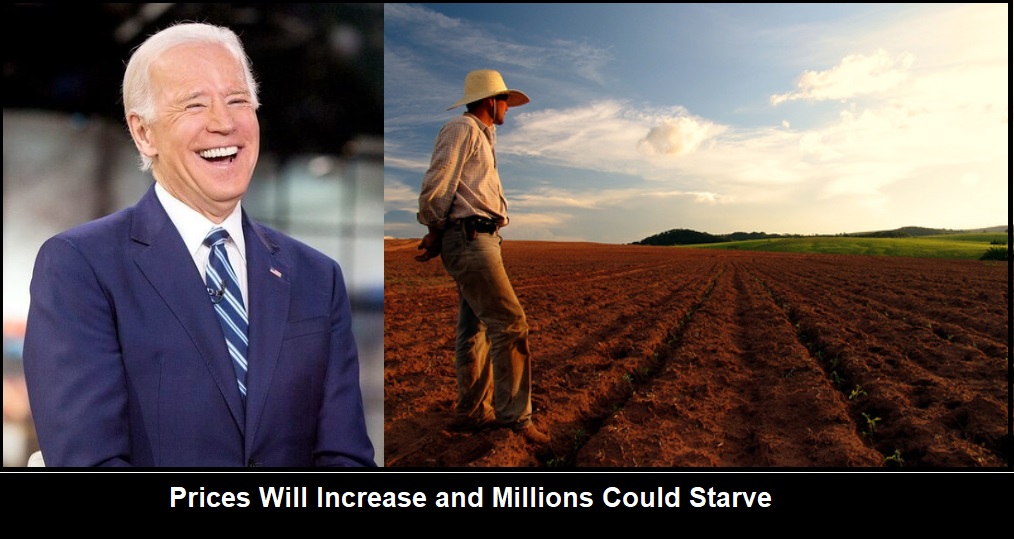As CTH has noted since last October the rapid increases in fertilizer costs could potentially create a major issue for global food supplies later this summer. As the farming costs continue escalating, including fertilizer and diesel fuel prices, this will eventually lead to major price increases on the harvests. Field to fork inflation is looking increasingly severe later this year; what we have called the third wave of inflation.
Beyond prices, a primary impact in the U.S. market, concerns are now escalating about grain shortages {SEE HERE} and lower European crop yields which will lead to less food products on a global basis. According to information shared by ZeroHedge, “We think it will take at least 2-3 years to replenish global grains stocks,” Illinois-based CF Industries Holdings Inc.’s president and chief executive officer Tony Will said in a statement in Wednesday’s earnings report.”
Axios is reporting on the continued escalation of fertilizer prices; however, they conveniently and purposefully avoid noting the origin of the problem in North America is directly the result of Joe Biden’s immediate energy policies that drove up the costs of natural gas (a critical component):

AXIOS – “Skyrocketing fertilizer costs — like those made from nitrogen, phosphorus and potassium (NPK) — are driving up food prices and, worse, threatening food security around the globe.
State of play: Prices for NPK were up 125% in January from a year before, and rose another 17% from the beginning of the year to March, according to data compiled by the International Food Policy Research Institute (IFPRI).
-
- The looming European ban on Russian natural gas (a critical component in manufacturing some fertilizers) could worsen the situation.
- “We’re in a dire situation right now,” said Svein Tore Holsether, the CEO of fertilizer maker Yara International, at a seminar hosted by IFPRI this week.
- If farmers use less fertilizer, they can’t produce as many crops — and that raises the specter of “malnutrition, political unrest and, ultimately, the otherwise avoidable loss of human life,” Bloomberg reported.
The big picture: Prices for these heavily traded raw materials were already rising in 2021, because of a myriad of factors: Hurricane Ida in the U.S., an upsurge in demand after the pandemic, supply chain issues, and rising natural gas prices that predated the war in Ukraine. (more)
It is clear to see the lower price of fertilizer when President Trump triggered U.S. energy independence through his use all resources method of energy development. Oil and natural gas prices dropped significantly as a part of the Trump energy policy which was directly connected to the his overall U.S. America-First economic policy.
We went from Trump inspired energy independence, low gasoline prices and the stable export of liquified natural gas (LNG) – to energy dependence, high gasoline prices and extreme increases in natural gas prices as a direct result of Joe Biden energy policy.
The downstream consequences of energy policy are extremely severe. Higher energy costs, higher petroleum costs, higher transportation costs and higher raw material costs drive inflation on all manufactured goods, including farm products.
The energy policy is not a mistake. These economic outcomes are a direct result of Joe Biden executing his Green New Deal / Build Back Better energy policy. Shortages of food are an outcome of chasing the climate change unicorn energy policy.
Yes, there is a direct connection between climate change energy policy and people starving around the world as a result of it.

Like millions of Americans, regitiger left work, saw the market was down 5%, and then paid $80 for a tank of gas on the way home.
Life would be so much better if the Democrats would go back to just calling us racists.
(lifted from jon turley comments section)
Guys I learned of Michael Yon former G Beret (I think) from Matt Bracken former SEAL. He sometimes posts here and links your articles often SD. He said hopefully we can all laugh at them both this time next year. Reading Yon, who knows his shit, rang the bells. It’s what I see happening too regarding the government taking the produce of farms. Hopefully some states will make that difficult for them but not all. The government will then distribute or sell accordingly. In this day and age they probably won’t take it forcefully; nah they are too smart for that. Instead they will give the farmer a lot more money for his goods than he can get on the open market.
Ice Age Farmer is another to listen to. He’s on Bitchute I think.
https://michaelyon.com/dispatches/famine-burst-sans-edit/
Really great read. I will be reading more of his articles!
War with Russia is coming. And soon. Be ready
They certainly are prepping it. Not sure how you stop a nuclear war once it starts. I believe this whole thing was goaded to start food shortages. It’s hard to say sometimes what side of the line Putin falls. Personally I don’t think he had a choice but to invade. Failure to do so would have driven his approval numbers very low. It was now or never I suspect.
Another conspiracy theory came through
I work at a golf course in Ohio. Our fertilizer costs TRIPLED since last summer in price…..Get ready folks, Food prices are about ready to skyrocket….
Anyone else know what those products and processes are used for?
Almost all famines are the result of government actions and policies.
People who refuse to learn from history are doomed to not only repeat the disasters of the past but exacerbate these disasters.
But as Demorats say, “never let a crisis go to waste” and they are expert at creating disasters rather than solving problems.
Show me a Liberal and I’ll show you someone longing to man the ovens at Dachau.
I am very fuzzy on the science, but at one time in the history of man, farming was done in a combination mode which included crop rotation, animals and animal manure – which is fertilizer. This was farming on a small scale. The earth was replenished with the nutrients certain crops used up while growing.
Fast forward to corporate farming and no earth nutrient replenishment and we need fertilizer.
Now we cannot grow any crops in the earth because the earth has no nutrients.
Hmmm.
I wonder what we are going to do about that.
x